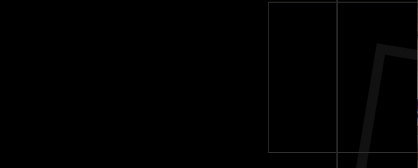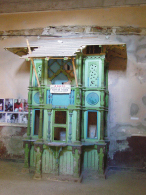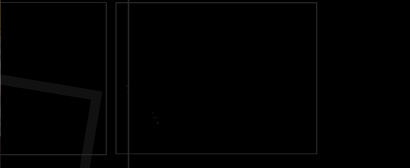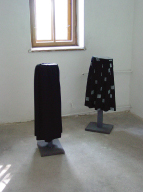-an interstitial interpretation of a souvenir from "Periferic 6" Biennial
Applying the dynamical logic characteristic
for contemporary cultural practices to the controversial field of visual arts
could conduce to the identifying of a process of adequating the intentions
of an initiative to the most proper form in order to sustain an attitude towards
a community that would define its expectances taking into account an interest
into a polishing of urban sharing of the living.
It is into this kind of intentional dynamics that one can ascribe the first
major contemporary art event in Romania, offered in the appropriated shape
of an "international Biennial", an event which is the consequence
of five annual festivals organized with the aim of promoting contemporary
visual arts within the thematic perspective of "periphery".
Organized in Iasi by the curator - institution Matei Bejenaru (visual artist and lector at the "George Enescu" Arts University), the five editions of "Periferic" Contemporary Art Festival have presented to the public unfamiliar forms of artistic expression, from performance to site-specific installations. In time, a group of artists and "friends" of contemporary art was constituted, that became known officially as the "vector>" NGO. Eventually, "vector>" turned into a Cultural Association and, since 2001, it organized a series of exhibitions, actions, conferences and workshops in the field of contemporary visual arts. At the initiative of Matei Bejenaru to invite an international curator, the "vector>" Association put under the eyes of the public, at the beginning of June 2003, the first Contemporary Art Biennial in Romania: "Periferic 6".
Using a revealing metaphor extracted from
the writing of Walter Benjamin - "A childhood in Berlin around 1900",
the Sweden-based curator Anders Kreuger has configured the concept of this
biennial adapting it to his becoming aware of and working the given social
and cultural data of an urban habitat as Iasi. Visiting this "bastion"
of one of Europe's extremities, Kreuger had the revelation of a "prophetic
corner" and this determined him to have in mind for this exhibition not
as much a religious meaning as a poetic one.
Therefore, adapting the concept of "Prophetic Corners", Anders Kreuger
invited a series of international artists, assigning them to re-describe the
context and to offer a new cultural look of the city.
The good intentions had to be confronted with the susceptibility or even the indifference of a community used to a good dwelling in its own preferences for the figurative and the volume. The inertia of receptivity is directly proportional with the lack of reaction, and the intention of the reader associates itself, most of the times, with the desire of confirming the deja-vu-s. Typological segmentation of the public can lead to ironies or appraisals. It is not in the intention of this text's author (at the same time "reader" of the Biennial) to classify the public on the ground of the failure characterizing the dark side inherent to any such event, that tries to defy the norms of an exhausted art critique, of commercial parameters or of the security of social involvement.
Any text trying to eulogize contemporary art must contain the intuition of the readers' category that would spend any of their time with such a narration, which multiplies the blocks of enunciations inserted in the field of this art's discourse, extended to such a degree that it becomes impossible to cover it completely. Leaving in suspense the criticizing of the art's public, the author prefers to put in suspense his own (voluntary private and shared) reading of some works exhibited at the "Periferic 6: Prophetic Corners" contemporary art biennial; this is for demonstrating not the "death of the author" in the case of a contemporary art work, but the possibility for a viewer to claim his background tradition, the socio-political context in which he's striving and the individual pre-dispositions which one has cultivated in dependence to the ideology of happiness of the community in which he builds, makes conversations and celebrates.
I remember a walk through the Anthropological
Garden in Iasi. It was at the beginning of our century. I had reached in front
of a historical building, which I heard was the place of an art exhibition,
contemporary. This corner of the Anthropological Garden was showing signs
of something that was to come. It was a prophetic corner. At the entrance,
one could hear a voice, coming as from an amniotic liquid; the talking was
about water, and every image could be seen anywhere. On a wall, there were
stuck some photos, of some young fellows people said they were passing to
the next generation, and each one of them was doing something else. At the
end of a hall I saw the word SHOP. A few objects were put on some improvised
tables, a few colored manuals explained how to act vis-à-vis the exhibited
objects. I understood I was being invited to a trade, and I wasn't supposed
to imitate no one, and I could choose, and participate, and communicate. I
entered, on the right side, to another hall, and to my left there was a room
in the middle of which there were exhibited two skirts, not mannequins wearing
skirts, and it was said they were poisoned, this didn't affect me, and then
someone told me these were the models of clothes belonging to some deformed
women. As I entered the room in front of me, I saw at my feet two packs of
newspapers, and there were the opinions, feelings, frustrations, hopes, idiosyncrasies,
needs, stumbles, detachments (…) of some Romanian intellectuals, I don't
know how prototypes but known, I don't know how justified to speak in so many
people's name, but stimulated. As you raised eyes, you could see a fragile
dress, of a little girl, who had probably danced in it sometimes, touching
the adults, and she had been caressed, applauded, kissed. And if you looked
at that object, as it was exhibited there, as if hung up by accident, it was
creating a feeling of happy past and nostalgic sadness. In the same room there
was a painting, three pictures representing the same woman, frightened, running
by a wall, looking back, over the shoulder, in a monochromatic semi-darkness.
One next to the other, the 3 paintings representing the same image, were like
frames of a film, mute and tensioned. There was nothing I could have done
for that woman. I heard a voice, someone speaking in Russian, in the room
in front of me. On a wall, a film was projected, resembling a painting, an
image in a park, where, from time to time, distant shadows of people appeared,
walking in a different world than that of the narrator, who was not the actor
speaking in the meanwhile, telling a story which had something to do with
the pretext of a different story, without much happening really. It was a
mixture of issues, and types of narrating, and contradictions, and intentions,
and interspersions; and so I entered a room found inside the last room I was
talking about, and I found myself staying at the window of a train, and the
film projected here was made on the corridor of a train, that was in a challenge
with another one, running in parallel, in speed, each one on his road, and
you realized you didn't know where you were going. Then I went out and forwarded
to another room, where the building seemed to end, and I saw a fresco to my
right, it was a familiar image, and at the same time something wasn't right,
there were fragments cut up from the city, ancient buildings, with their remote
history, new buildings, with their recent history, and the whole atmosphere
was colorless, and I entered one last room where a TV and a DVD player were
installed, I saw a few red and playful points on the sky of a very peaceful
city, in a night, which no one seemed to notice, although these were happening.
It was the moment for me to explore the building, to see whether something
more was to be discovered, and I realized I could pass to a different wing
of the building. I met an extension of the SHOP, then I entered a very high
room, with written and painted walls, and where the words were missing there
were images of the words instead, and in the middle of the text there were
drawings on a tracing (news)paper, representing some burials, emphasizing
a globe shaped on a plastic balloon ; this was hung up with a thread over
a shot mark that was flowing to the wall like the watches in the "Persistence
of memory". Someplace else, on a wooden table, there were some bunches
of newspapers, containing the images of some news and "second-hand"
book stands, and they were all arranged like in a stamp book, without any
legend, and I was thinking at the value of this information, if it was metaphorical,
rhetorical, ironical, critical… Entering a room aside, I saw, in a video
recording, more characters talking about curse, with no charm, no substance,
still trying to convince themselves that they are well informed about the
common interpretations of this taboo, that starts losing its power when superstition
is considered to be a belief one cannot live well with.
I turned back to the high room and I looked down, to a waterless pool, which
seemed to be a niche, in time, and I saw a white on black collage, publications,
posters, drawings, texts about anticipation, posters about conferences and
drawings with mutants and complicated machines. Raising the look, I saw three
photographs, three characters gesticulating at a table, trying to persuade
each other of something, in an image seeming to evoke one of the stages the
Spirit has to cover in Hegel's phenomenology. Stepping into the last room,
I noticed a film was projected, in which someone was dancing, with a certain
clumsiness, but sensitive and thrilling, as something wasn't right, something
special was happening, in a completely white space, with a dancer dressed
in black, and I remember some of his movements, the sound of music and my
emotional state from that time. Without communicating with the feelings of
ridicule and admiration which the movie about the dancer raised in me, an
installation in the same room was projecting upon my clothes, upon me, slides
with words designating different states of mind. In the room there were three
more photos. One represented a woman at a window, holding a cigarette, the
lighter was on the window's edge, and all the other buildings around had smoke
at the windows, as if a brucknerian emperor had decreed that everybody should
smoke one cigarette per day at an exact time, so as to reduce pollution. In
each of the other two photos, two characters are talking to each other, on
the same spot, next to a car upon which a cat is sitting, they are like two
elements in a still life, and they spell vapors instead of words - the words
which, most of the times, when you met someone in the street, are nothing
more than crossings of the breaths. I sat on a stone bench, in the last room,
thinking there's prophesying here too, the change of look, a different way
of seeing things, and this might have happened a long time go, without us
knowing it, and if we watch it from this corner we should see the room in
its hole, and come close to the windows, and look where we're going to without
forgetting the path we'll choose. But I see everything as if in a transparent
interstice, as from a tunnel depicted by Sabato, where communicating is based
on jealousy, leading, therefore to self-isolation and self-sufficiency. No
one communicates to no one, except through a resisting strategy of simulating,
where only the terminals are real (and camouflaged). I left my stone bench,
I finished my number, I made a projection beyond the exhibition, an exemplary
part of a biennial, beyond the interstice, an aleatory segment of an interpretation,
and all that's left to me was a memory: that the Anthropological Garden of
the Art World is really large.
Any attempt to reproach to me the appeal I made to avoiding, through a mental experiment - or through a fiction, based on a real event, doubled by concluding reactions - the exposing of self-sufficient characters' identity, the characters that crowd the Anthropological Garden of the Art World, would be prevented by a common sense retaining me from opening the appetite of staging those instincts that have nothing to do with the domain of thinking.
For reasons of professional hygiene I don't want to amplify the critical note which happened to accompany my telling the story of a memory; still I'd like to close with saying that an international contemporary art biennial should not be contemplated from the distance.
Catalin Gheorghe, theoretician and analyst of contemporary art, post-graduate
in Aesthetics and Philosophy of Art, member of the vector> group, Iasi








